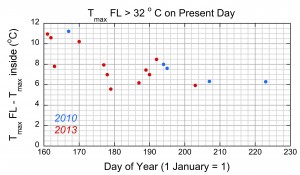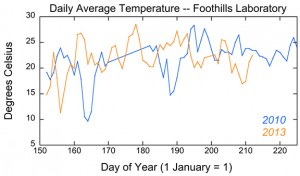This week we continue last week’s blog on keeping cool in the summer (read Part I at http://blog.globe.gov/sciblog/2013/12/17/keeping-cool-in-the-summer-part-i/), provided by long-time friend of GLOBE, Dr. Peggy LeMone, Chief Scientist for the GLOBE Program from 2003-2009. Dr. LeMone is currently working in the field of weather and cloud formation at the National Center for Atmospheric Research (NCAR).
Dr. Peggy LeMone,
Credit: UCAR
We installed new insulation last year in our roof and outer walls, and installed double-pane windows. Our impression is that insulating has kept the summer inside temperatures cooler, especially on the hottest days. For example, prior to insulating, we recall isolated cases of inside temperatures to 29.4 Degrees Celsius. However, we do not have enough data to show a clear effect. I can think of two reasons for this.
First, the weather varies from summer to summer. Looking at Figure 4 from Part I (see below for your convenience), one sees comparable indoor-outdoor differences for 2010 (before re-insulating) and 2013 (after-re-insulating).
 Figure 4 (from Part I). Difference between living-room max temperature and that at Foothills when outside temperature exceeds 32o Celsius.
Figure 4 (from Part I). Difference between living-room max temperature and that at Foothills when outside temperature exceeds 32o Celsius.
My hypothesis is that the “good” inside-outside temperature differences for 2010 can be traced to some very cool periods in the middle of the summer, as can be seen from Figure 1. We took advantage of such cool periods to ventilate the house, which cools it (the walls, floors, etc.) enough to keep it cooler during the next period of warm temperatures.
 Figure 1. Daily average temperatures at Foothills Laboratory, for 2010 and 2013. Data are mixing between Days 170 and 185.
Figure 1. Daily average temperatures at Foothills Laboratory, for 2010 and 2013. Data are mixing between Days 170 and 185.
The second reason is that the insulation can only slow the warming of the house itself; it can’t stop it entirely. (Were I to have data like that in Figure 3 from Part I for 2010, I would guess the daily swings of the inside temperature would be larger than for 2013.)
Perhaps easier to understand is an example from nature. The soil temperature varies much less than the surface temperature. And, the farther down one gets, the less the temperature varies during the day – and during the year (see
http://blog.globe.gov/sciblog/2008/03/17/puddles-and-soil-temperature-part-2-why-is-the-water-feeding-the-puddle-not-frozen/ for graph that shows this). Surface vegetation, and soils closer to the surface insulate soils and rock farther down.
If you have ever taken a tour through a cave, the guide often mentions that the temperature in the cave is close to the average annual temperature for that location. This is because the cave is far enough down that the insulating upper layers prevent much temperature change during the year.
People actually take advantage of this steady year-round temperature to moderate the temperature in their house. Pipes are installed deep into the ground beneath a building. During the summer months, fluid in the pipes is cooled by the surrounding earth; and the cool fluid is pumped up into the house to cool the air. In the wintertime, the ground below the house is warmer than the air outside, so the same system can be used to help heat the house.
Does your school collect soil and air temperature data? Have you noticed a difference in these two datasets on very warm days? Let us know by adding a comment!
With Earth warming due to increased concentrations of greenhouse gases in the atmosphere, do you think caves are warming as well? Why? In what parts of the world would caves warm the most? Why?


Thanks u so much. good article. but i have one question, how many time you keep?
Great article! I completely agree if you take precautions in protecting your home the summer and winter months will be a lot easier on the pocket book.
A survival guide! Great article and great thoughts!
to the summer heat is no general right hand man to protect the environment, planting more trees, forest protection, waste emission
It All depend on the area. Like in some area its too cold that cave and other placess are also cool. you are bit right that because of gaseses in the atomsphare its become hot.
Thank you very much. Great article.
Summer in many countries is truly a nightmare.
I think it is essential for humans, it can help us avoid diseases summer. Thanks for your great article .
.
Interesting article and even more interesting is the information regarding the cave’s temperature. I can see where the temperature would not have a great deal of change. This makes a lot of sense.
Thank you very much. Great article.
Thank you so much
while the temperature of the Earth is heating up by the day, what this research project is very important. I hope the group will work to complete the project as soon as possible to serve the society this great research.
thanks for all